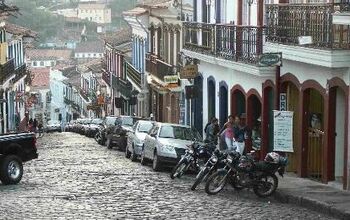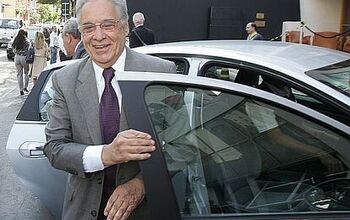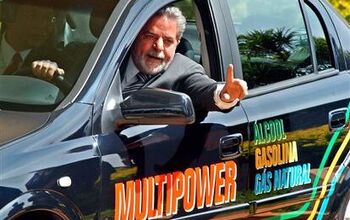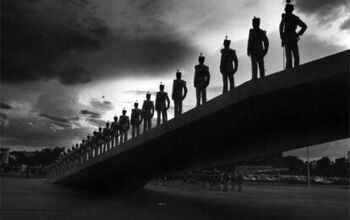History of the Gol (Parte Um)

History of the Volkswagen Gol (Parte Um) takes us from the BX project that gave rise to the Gol, to the late-90s when the Gol was almost unstoppable. However, chinks were being taken from both the Gol’s and VW’s armor. Which will become evident in Parte Dois, to follow tomorrow.
Many of you have asked me to do a history of the most sold car in the story of the Brazilian automobile. Be careful what you wish for. We will now (tach and) dwell on Volkswagen’s Gol history. The Gol is a singular car and very interesting. Many parallels can be drawn between its trajectory and VW’s. One thing is for sure: VW marches to the tone of the Gol in Brazil. As the Gol goes (or not), so does Volkswagen.
It all started back in the 70s. The Beetle was falling by the wayside and VW knew it. Trouble was, what car could substitute that old age favorite?
Why Volkswagen insisted on these solutions (rear-wheel drive, air-cooled engines) is open to debate. Many affirm that Brazilians had grown up with these solutions and would not let go easy. Others said that Brazilian conditions were so different, the German solutions just wouldn’t fly. The main argument was that the cars the Germans were coming up with (Polo and Golf) were just too weak. That however does not explain why more modern solutions were killing the Brasilia (like the front-wheel drive Ford Belina), while the Passat was cannibalizing TL and 1600 sales. Meanwhile, by 1980 the Beetle was hemorrhaging market share due to increased competition from, among others, Chevy’s Chevette and Fiat’s 147.
VW then decided to go with the Brazilian solution. Phillip Schmidt, then Director of R&D at VW do Brasil, used his experience in the development of the Polo and worked on a new structure on the first Polo’s platform. The BX project was born. Initially inspired by the Passat, the first studies already showed the preference for a hatchback. However, in the end, the prevailing influence was the Scirocco. This would mean the first Gol’s would have a back seat with little space. That wasn’t a problem in the sporting Scirocco, but in a car with pretensions to serve a family, this would be a definite compromise. Compromises would mark much of the Gol’s career.
In May 1980, the first Gol reached the marketplace. It came with a 1.3, air-cooled engine, good for 42 ponies. The engine was mounted transversely. This intermediary solution, never tried in Europe (though a prototype known as EA-276, from 1969, is now shown at VW’s Wolfsburg museum), proved not to be a hit in Brazil either. Its rather crude mechanical set-up contrasted sharply with the modern and pleasant design. Some say VW made a go at it to keep traditional Beetle owners in the fold. VW was fearful of their reaction. However, it was also true that at that time, VW was already producing its 1.5 and 1.6 at peak capacity. Putting it in the Gol would mean that the Brasilia and Passat would suffer. So, the mark of the Gol, again, showed itself, a compromise of Beetle-derived mechanicals in a modern, Brazilian-developed shell.
The public? Not impressed. Sales didn’t take off. But, VW acted quickly. In February 1981, a 1.6 Gol debuted. It had 51 hp, 10.5 m.kgf of torque. However, the engine was still air-cooled and longitudinal. But it had double carburation. As always, a compromise. Top speed improved to 143 km/h (the first Gol barely made 130 km/h). Acceleration was brisker and after 16 or so seconds it would reach 100 km/h. At this time the Gol started breeding. It originated a 2-door sedan called Voyage. This car debuted miles ahead of the Gol. It used the Passat’s 1.5 water-cooled engine. It was faster, more economical and much quieter than the “air” Gol.
For some reason though, the sedan never made it out of the hatch’s shadow. The Parati, launched in 1982, would shine though. It would sell more than the Voyage. In the 80s, Brazilians showed some good taste. They preferred the SW over the sedan (though over time this would be turned on its head). The Parati was so successful in fact that it even managed to steal sales from larger SWs and would become a car for urban playboys.
The Gol suddenly became a hit. So much so that the Brasilia was retired. The family though would not be complete until the arrival of the Saveiro pick-up in 1983. It used the same engine as the hatch, but urban playboys would fall in love with it. Slowly, but surely, more and more Saveiros were sold to city dwellers. Lots of them young, male and stupid. It would be (and still is) a hit among the tuner crowd.
In 1984 the “hot” Gol version came out. Using the German’s Golf valve command, it used a water-cooled 1.8, which made 90hp. As the car weighed only 930 kg, it would hustle to 100 km/h in under 10 seconds. From there it would go on accelerating until it topped out at 180 km/h. This car made up much of the fame of the Gol and gave VW that elusive halo effect. In the closed Brazilian market of the 80s, it was the stuff of dreams.
In 1985, finally!, all Gols and Saveiros received a water-cooled 1.6. Quieter, more economical and powerful than the air-cooled 1.6s, it makes one wonder how far behind the times Brazilians were in the 80s. Some protested the change, but most were ready to move on. In fact, it was this year that the Gol would take first place in sales. It would not relinquish that hold until 2011 (possibly).
1987 came and brought the first extensive re-design. Headlights and back-lights grew. Bumpers were made of plastic now and were integrated into the body. In this form (though heavily revised against the Brazilian-market version), both Voyage and Parati made it to America and Canada. There they were known as Fox and Quantum respectively.
In 1988, the Gol GTi was launched. This car firmly implanted in Brazilians minds that VW was the technology leader. It was the first Brazilian car to get electronic injection. As a result, its 2.0 mill produced a healthy herd of 112 horses and 17.5 m.kgf of torque. Compared to other cars of the time, it was a rocket ship. And it’s a collectable car today. It managed around 185 km/h as top speed and a 0-100 km/h time of 8.8 seconds.
In 1992, after another re-skin in 1991, using a Ford-engineered (result of Ford and VW’s brief and unholy alliance known as Autolatina) AE-1.0, VW launched its attack on Fiat’s Uno Mille. Owing to a tax policy favoring small-engines, Fiat had been quickest to respond to the government’s prodding. VW came in second. This segment would eventually reach more than 70 percent of the market (in 1997 or thereabouts) and still (to this day) commands around 50 percent of the market. VW’s 1.0, though offering only 50 hp and 7.3 m.kgf, was well received because it ran very smoothly and could rev very high without any undue drama. Revving became the name of the game.
In 1994, 14 years after its debut, the scenario had changed radically. The 1.0 car was fast becoming a mainstay. In this context, the Gol now competed against Fiat’s very economic Uno, Ford’s Escort Hobby and the sensation of the 90s, Chevy’s Corsa. Enter the soon and aptly nicknamed Gol “bolinha” (or little ball in English). Using most of the old mechanicals, stretching the wheelbase by 11 cm and softening and rounding off the until then characteristically square lines (from then on the first Gol would be known as the Gol “quadrado”, or square Gol), VW achieved a very pleasing design that effectively hid one of the car’s greatest compromises. Yes, the engine was still mounted North-South. This meant that in the interior, together with VW’s traditionally low seating position, the dashboard was an expanse of tall, drab, dark plastic. So much so that small pillows were often seen on the seats of parked Gols. The alignment of seats and pedals was made significantly worse in the new car (due to the compromises needed to fit the new shell onto the old platform). Not only were they misaligned, now the steering wheel itself was out of the proper alignment. To drive a Gol meant a weird S-shape of your spine. Thank God most of the Gol’s drivers were young (at least at heart) and blissfully ignored this. Or they thought, S-shaped spines were kinky.
This was of course offset by some of the Gol’s qualities. Did I mention that the 1.0 engine loved to rev? It was economical and very quiet and suave. The gearbox still had arguably the best linkage and throws in Brazil (though the competition was closing in quickly). The 1.6 engine stayed modern, efficient and economic throughout the 90s. Inside, higher trims received more modern lighting and instrumentation. Lesser versions sometimes had to do without back-lights for any lights in the car save those in the instrument cluster. Space in the back was much improved, as was access to the trunk.
At first VW, for some crazy reason, launched this new generation of the Gol Parati only with 3 doors. This undoubtedly helped the competition, being that Fiat’s Palio Weekend SW (available only in 5 doors) overtook the Parati and has held on to first place in sales until last year. The Saveiro pick-up also suffered intense heat and eventually let go of first place. Again, against a Fiat rival. The Strada, boasting a more modern engineering and extended cab and single cab body styles, reversed positions with the Saveiro and went on to take over 50 percent of this juicy little trucklet market in Brazil.

More by Marcelo de Vasconcellos
Latest Car Reviews
Read moreLatest Product Reviews
Read moreRecent Comments
- Lorenzo Yes, they can recover from the Ghosn-led corporate types who cheapened vehicles in the worst ways, including quality control. In the early to mid-1990s Nissan had efficient engines, and reliable drivetrains in well-assembled, fairly durable vehicles. They can do it again, but the Japanese government will have to help Nissan extricate itself from the "Alliance". It's too bad Japan didn't have a George Washington to warn about entangling alliances!
- Slavuta Nissan + profitability = cheap crap
- ToolGuy Why would they change the grille?
- Oberkanone Nissan proved it can skillfully put new frosting on an old cake with Frontier and Z. Yet, Nissan dealers are so broken they are not good at selling the Frontier. Z production is so minimal I've yet to see one. Could Nissan boost sales? Sure. I've heard Nissan plans to regain share at the low end of the market. Kicks, Versa and lower priced trims of their mainstream SUV's. I just don't see dealerships being motivated to support this effort. Nissan is just about as exciting and compelling as a CVT.
- ToolGuy Anyone who knows, is this the (preliminary) work of the Ford Skunk Works?

































Comments
Join the conversation
As someone who bought a 1990 Fox two-door sedan and put 91,000 happy miles on it, I have to say I am a big Gol fan. Wish I had that car back. Thanks, Marcelo!
I love the design of the Gol quadrado and hate the Gol bolinha. For me, this design change is another of the inexplicable VW decisions (for sure the design needed to be modernized but since you are paying for it, demand a better job!) Now, the fact that the Gol Gti and the Escort XR3 were dream cars of Brazil in the 80's shows in what terrible situation we were car wise in that decade. So sad.